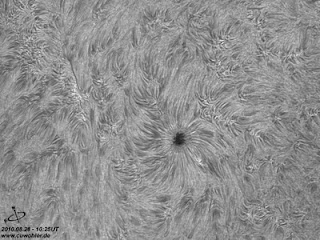The monsoon weather pattern remains intact here in the Old Pueblo, which means that there is no nighttime observing. This year we are actually ahead of the average annual rainfall, and for that, even the amateur astronomers are grateful. Personally I can't wait for a good clear night so that I can try out the new to me 12" LX200 SCT that I recently purchased...tune in next month for a review of this scope. And, if you are interested in buying a nice 9.25" SCT, by all means send me an email!
A quick shameless self-promotion...Lunt Solar Systems, the manufacturer of my solar telescope, maintains a blog on the company website. Yesterday, yours truly was the subject of the blog...check it out here: Sky to Paper
This morning I set up my solar telescope and was treated to nearly perfect seeing. The atmosphere was unbelievably stable and even at the highest powers, details on the sun remained sharp. It may have been the most stable solar observing session I have had, since purchasing the scope. Transparency was not quite as good as there was a bit of haze in the eastern sky, but this is typical this time of year with such high humidity in the desert. I completed the sketch below at 1530 UT (8:30 AM MST).
There is only one officially numbered active region on the face right now, AR 11101 in the northeast. This region contains a very dark spot, that at high magnification appears to be splitting in two. It will be interesting to watch this spot over the next 24 hours. To the northwest of the spot, there are three small areas of plage. The southern two of these areas are separated by what appears to be some bi-polar filamentary structure. Again, this could be a sign of increasing activity in this region, and it may develop into a distinct active region over the next day. There is also an area of plage in the southern hemisphere, although this area did not display any signs of activity and may be what is termed an ephemeral region.
Cai-Uso Wohler, a solar observer and imager in Denmark, captured the photo below about 5 hours before my observation, and posted it on the Cloudy Nights Solar Observing forum. You can see that the sunspot in AR11101 was not yet showing any signs of dividing.


No comments:
Post a Comment